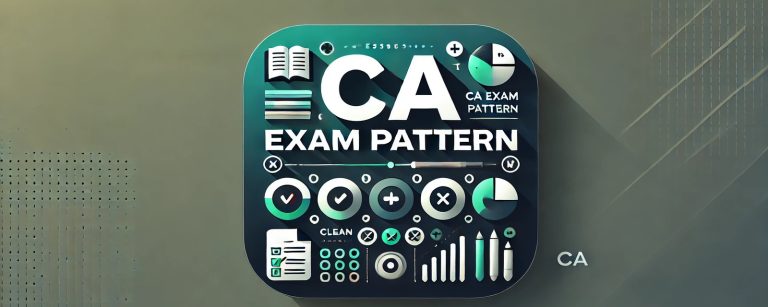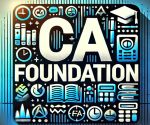The Chartered Accountancy course is one of the most prestigious and challenging professional qualifications in India. The Institute of Chartered Accountants of India, ICAI, governs this course. CA course trains students in accounting, auditing, taxation, and financial management. Understanding the CA exam pattern is very important for aspiring Chartered Accountants because it helps them prepare well for each stage of the course. The three levels of the exam are CA Foundation, CA Intermediate, and CA Final. Every level differs from one another as each has a different framework and degrees of complexity to test the facts both theoretically and practically.
What is CA?
CA full form is Chartered Accountant. This course is a professional program for dealing with complex financial and taxation matters. The student will acquire expertise in a deep understanding of subjects like accounting principles, auditing, tax laws, corporate finance, and business regulations. It is considered to be the most highly valued qualification across the globe for any finance professional.
The course CA is operated by ICAI, wherein the student obtains both theoretical as well as practical knowledge. So, it will have three stages:
- CA Foundation: The first and entry-level to start with the course for the students after completion of class XII.
- CA Intermediate: IPCC It is the mid-level course that is available to the students, who have successfully cleared the foundation exam or taken through the direct entry route at the end of graduation.
- CA Final: It is the last and highest level of the course.
- Besides passing such tests, students have to undergo 3-year training in Articleship. This practical exercise gives real exposure to students dealing with accounting, auditing, and taxation; hence empowering them for a proficient career.
The CA qualification is very diversified because it provides options for practice in various industries like corporate finance, public practice, or even entrepreneurship.
CA Eligibility Criteria
A study of the CA eligibility criteria is one of the critical steps before entering the CA program. The course is available to students who complete Class XII besides graduates and postgraduates. Based on one’s educational qualifications, there are mainly two routes leading to entry to the course,
- Foundation Route: For students entering CA from class XII.
- Direct Entry Route: Open to graduates and postgraduates who meet the percentage criteria.
Both pathways have requirements to ensure that the students are well-prepared for the challenges of the course.
CA Exam Pattern
The CA exam pattern is planned to check all the knowledge about theoretical concepts, analytical thoughts, and applications in students’ minds. All three levels-the Foundation, Intermediate, and Final exams are given offline or on paper. Objective and subjective type questions are framed for both to test a student on all financial knowledge dimensions.
The CA exam pattern helps students develop a strong base of basic principles at the initial levels and gradually progresses toward more advanced topics. For example, in the CA Foundation exam pattern, students are exposed to basic concepts in accounting, business law, mathematics, and economics. CA Intermediate focuses on core subjects such as taxation, corporate law, and auditing. In contrast, CA Final focuses on advanced topics like international taxation, risk management, and strategic cost management. Each paper carries 100 marks, and exams are time-bound. Hence, the exams would evaluate students not only theoretically but also in their ability to apply knowledge to real-life phenomena. Let us move further for more details on each level of exam pattern.
ICAI CA Exam Pattern
The ICAI CA exam pattern is uniform for all three levels with a difference in the type of questions, difficulty, and focus areas. Here are the key highlights of the exam pattern:
| Feature | Details |
| Levels | CA Foundation, CA Intermediate, CA Final |
| Total Papers | 4 papers in Foundation, 8 papers in Intermediate, 8 papers in Final |
| Question Format | Subjective (descriptive) and Objective (MCQs) |
| Mode of Examination | Offline (pen and paper) |
| Marks per Paper | 100 marks |
| Duration per Paper | 3 hours |
| Negative Marking | Applicable for MCQs in Foundation and Intermediate levels |
| Passing Criteria | Minimum 40% in each paper and 50% aggregate in a group |
| Medium of Exam | English or Hindi |
CA Foundation Exam Pattern
CA Foundation is the entry-level Chartered Accountancy course and marks the entry for students who have joined after class XII. At this level, it introduces the basic knowledge of accounting, business laws, mathematics, and economics to the students. The student needs to know about the pattern of the CA Foundation examination since it will act as a starting point for further more complex knowledge at the Intermediate and Final levels.
There are four papers in the CA Foundation examination. Of these, two are descriptive or subjective types and require a lot of written answers, while the other two are objective types that consist of MCQs. In addition to MCQs, negative marking is also present in objective papers, which deducts 0.25 marks for every incorrect answer.
| Paper | Type | Marks | Duration |
| Principles and Practice of Accounting | Subjective | 100 | 3 hours |
| Business Laws and Business Correspondence | Subjective | 100 | 3 hours |
| Business Mathematics, Logical Reasoning | Objective (MCQ) | 100 | 2 hours |
| Business Economics and Commercial Knowledge | Objective (MCQ) | 100 | 2 hours |
CA Intermediate Exam Pattern
The CA Intermediate course is the second level under the Chartered Accountancy course. It is much more advanced than the foundation level and includes core subjects that are usually focused upon for a career in finance. The paper pattern for CA Intermediate has two groups, which comprise four papers in each group. The students can appear for both groups together or one group at a time depending on their preparation.
The subjects that the CA Intermediate examination covers include accounting, corporate law, taxation, auditing, cost management, and financial management. These subjects are designed to test a student’s ability to apply concepts to practical problems. The CA Intermediate level has two groups, each consisting of four papers.
| Group | Paper | Type | Marks | Duration |
| Group I | Accounting | Subjective | 100 | 3 hours |
| Corporate and Other Laws | Subjective | 100 | 3 hours | |
| Cost and Management Accounting | Subjective | 100 | 3 hours | |
| Taxation (Direct & Indirect) | Subjective | 100 | 3 hours | |
| Group II | Advanced Accounting | Subjective | 100 | 3 hours |
| Auditing and Assurance | Subjective | 100 | 3 hours | |
| Enterprise Information Systems & SM | Objective (MCQ) | 100 | 3 hours | |
| Financial Management & Economics for Finance | Subjective | 100 | 3 hours |
CA Final Exam Pattern
The final and most technical level of this Chartered Accountancy course comes at the hands of the CA Final. It seeks to prepare aspiring accounting leaders by going all the way with high-end concepts such as strategic cost management, international taxation, and management of risk.
The CA Final exam pattern consists of two groups, each with four papers. In addition to this, students are also required to do case studies and practical tasks that resemble real-world challenges faced by Chartered Accountants. The CA Final has two groups, each with four papers.
| Group | Paper | Type | Marks | Duration |
| Group I | Financial Reporting | Subjective | 100 | 3 hours |
| Strategic Financial Management | Subjective | 100 | 3 hours | |
| Advanced Auditing and Professional Ethics | Subjective | 100 | 3 hours | |
| Corporate and Economic Laws | Subjective | 100 | 3 hours | |
| Group II | Strategic Cost Management | Subjective | 100 | 3 hours |
| Elective (e.g., International Taxation) | Subjective | 100 | 3 hours | |
| Direct Tax Laws and International Taxation | Subjective | 100 | 3 hours | |
| Indirect Tax Laws | Subjective | 100 | 3 hours |
CA Pass Percentage
The criteria to pass any level of Chartered Accountancy course is a universal requirement applicable equally at the CA foundation, Intermediate, or CA Final stage. Underlying the whole assessment, they also make students not only answer specific to every one of these various papers in particular but generally conscious of a bunch of those for which they seek admittance by meeting two core qualification criteria. At least 40% marks in each paper: This ensures that students have at least a minimum level of competency in every subject of the course. Scoring below 40% in any paper, even if the overall group average is 50% or more, will result in the student failing that group.
Obtain an aggregate of 50% in the group: Each group of the CA exams comprises a group of papers-four papers in Foundation and four papers per group in Intermediate and Final. The cumulative total marks obtained across all the papers in a group must add up to at least 50% of the total possible marks for that group. These passing criteria are set by the Institute of Chartered Accountants of India (ICAI) to maintain the stringent standard of the CA qualification and ensure that Chartered Accountants are adequately equipped with knowledge and skills. Let us break down these criteria in more detail, using examples to clarify how they work.
Detailed Breakdown of Passing Criteria
Sets of papers are what the CA exams have been classified under. For example, four papers exist in CA Foundation, while in CA Intermediate and Final, two sets of four papers exist at each level. Passing criteria involve the attainment of both;
- Above 40% Minimum in Each Paper: ICAI ensures that a student will have a minimum level of knowledge in each subject; hence, candidates must score 40 marks from the total 100 marks in every individual paper within a group. If the candidate fails to score 40% in at least one paper, that particular group will fail, which will happen irrespective of the aggregate score.
Example: A student appears for Group I of CA Intermediate, which is divided into four papers as mentioned below:
- Paper 1: Accounting
- Paper 2: Corporate and Other Laws
- Paper 3: Cost and Management Accounting
- Paper 4: Taxation
If the student scores 60 marks in Paper 1, 55 marks in Paper 2, 45 marks in Paper 3, but only 35 marks in Paper 4, they will fail Group I, even though the total of their marks is 195. This is because Paper 4 has less than the required 40% marks.
- 50% Aggregate in the Group: Besides scoring 40% on each paper, students need to score a minimum average of 50% on all the papers in the group as a whole. This way, students get a holistic view of all the subjects that are included in the group.
Illustration: A student sits for Group I of the CA Final, which comprises the following papers:
- Paper 1: Financial Reporting
- Paper 2: Strategic Financial Management
- Paper 3: Advanced Auditing and Professional Ethics
- Paper 4: Corporate and Economic Laws
CA Exam Pattern FAQs
1. CA exam pattern of all the levels?
CA exam pattern consists of objective and subjective type questions. The foundation level contains 4 papers, at Intermediate level comprises 8 papers divided into two groups and the Final comprises also 8 papers split into two groups.
2. What is the CA passing percentage?
Student needs to achieve a minimum of 40% of marks in a paper and must have at least 50% aggregate marks in a group for passing.
3. Does negative marking exist in CA exams?
Yes, at the Foundation and Intermediate levels, it applies to objective papers.
4. How long does a CA course take to complete?
CA course duration approximates 4.5-5 years for those starting after Class XII and 3-3.5 years for graduates, after getting through the Direct Entry route.
5. Can a student pursue CA along with graduation?
Yes, a student can pursue CA along with graduation. This combination is highly opted for by many students as it maximizes their academic and career prospects. However, one needs to have adequate time management as the CA curriculum is very rigid and demands lots of dedication.


